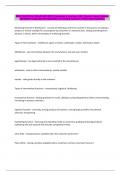MGT 103 FINAL EXAM REVIEW | Questions & Answers (100 %Score) Latest Updated
2024/2025 Comprehensive Questions A+ Graded Answers | With Expert Solutions
Marketing Channel of Distribution - consists of individuals and firms involved in the process of making a
product or service available for consumption by consumers or industrial users. Buying something from
Amazon, 7 Eleven, Kohl's all examples of marketing channels
Types of Intermediaries - middleman, agent or broker, wholesaler, retailer, distributor, dealer
Middleman - any intermediary between the manufacturer and end-user markets
agent/broker - has legal authority to act on behalf of the manufacturer
wholesaler - sells to other intermediaries, usually retailers
retailer - sells goods directly to the customer
Types of intermediary functions - transactional, logistical, facilitating
transactional function - Buying products for resale, selling by contacting potential clients and promoting,
risk taking in business inventory
logistical function - assorting, storing products at locations, sorting large quantities into desired
amounts, transporting
Facilitating Function - financing and extending credit to customers, grading and testing products,
marketing info and research that includes competitive trends
time utilty - having products available when the customer wants them
Place Utility - having a product available where customers can buy it and want to buy it
,Form utility - senhancing a product or service to make it more appealing to buyers
possession utility - entails efforts by intermediaries to help buyers take possession of a product or
service
direct channel for consumers - Channel A; represents direct channels where producers and consumers
deal directly with each other
indirect channel for consumers - intermediaries are inserted between the producer and consumers and
perform numerous channel functions. Channel B, C and D
direct channels for business - Channel A; maintains own salesforce and performs all channel functions
indirect channel for business - Adds industrial distributor (Channel B), agent (Channel C), or both
(Channel D) which is most ineffective
digital marketing channels - make products and services available for consumption by consumers /
organizational buyers. Combine electronic and traditional intermediaries to create time, place, form,
and possession utility for buyers.
direct to consumer marketing channels - Allow consumers to buy products by interacting with various
prints or electronic media without face to face meeting with salesperson. Examples are mail order,
selling, direct mail sales, catalog, telemarketing.
multichannel marketing - also called omnichannel marketing, is the blending of different communication
and delivery channels that are mutually reinforcing in attracting, retaining, and building relationships
with consumers who shop and buy in traditional intermediaries and online.
BOPUS - customers buy online and pick up in store
BORIS - customers buy online and return purchases in a store
,dual distribution - arrangement whereby a firm reaches different buyers by employing two or more
different types of channels for the same basic product
Strategic Channel Alliances - innovation in marketing channels, one firm's marketing channel is used to
sell another firm's products
Vertical Marketing systems - professionally managed and centrally coordinated marketing channels
designed to achieve channel economies and maximum marketing impact
What are three types of vertical marketing? - corporate, contractual, and administered
Corporate systems - the combination of successive stages of production and distribution under a single
ownership
forward integration - owning intermediary at next level down in channel
backward integration - a retailer might own a manufacturing operation
Contractual systems - independent production and distribution firms integrate their efforts on a
contractual basis to obtain greater functional economies and marketing impact than they could achieve
alone
Wholesaler-sponsored voluntary chains - involve a wholesaler that develops a contractual relationship
with small, independent retailers to standardize and coordinate buying practices, merchandising
programs, and inventory management efforts
Retailer-sponsored cooperatives - exist when small, independent retailers form an organization that
operates a wholesale facility cooperatively
Franchising - A contractual agreement between a franchisor (parent) and a franchisee that allows the
franchisee to operate a business using a name and format developed and supported by the franchisor.
, Manufacturer-sponsored retail franchise systems - prominent in the automobile industry, where a
manufacturer such as Ford licenses dealers to sell its cars subject to various sales and service conditions
Manufacturer-sponsored wholesale franchise systems - exist in the soft-drink industry. For example,
Pepsi-Cola licenses wholesalers (bottlers) that purchase concentrate from Pepsi-Cola and then
carbonate, bottle, promote, and distribute its products to retailers and restaurants.
Service-sponsored retail franchise systems - used by firms that have designed a unique approach for
performing a service and wish to profit by selling the franchise to others
Service-sponsored franchise systems - when franchisors license individuals or firms to dispense a service
under a trade name and according to specific guidelines
Administered Systems - achieve coordination at successive stages of production and distribution by the
size and influence of one channel member rather than through ownership
What factors affect channel choice and management? - target market coverage, buyer requirements,
and profitability
density - number of stores in geographic area. Three degrees exist: intensive, exclusive and selective
distribution
intensive distribution - firm tries to place products and services in as many outlets as possible. done for
convenience products usually
exclusive distribution - the extreme opposite of intensive distribution because only one retailer in a
specified geographical area carries the firm's products. done for speciality products
selective distribution - lies between the two extremes, the firm selects a few retailers in the area to
carry its products
Buyer requirements - information, convenience, variety, pre or post sale services




